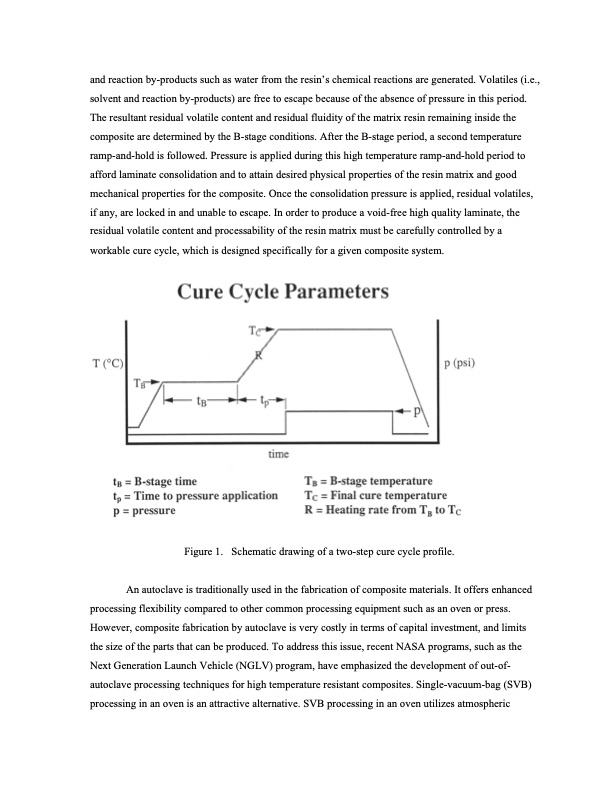
PDF Publication Title:
Text from PDF Page: 002
and reaction by-products such as water from the resin’s chemical reactions are generated. Volatiles (i.e., solvent and reaction by-products) are free to escape because of the absence of pressure in this period. The resultant residual volatile content and residual fluidity of the matrix resin remaining inside the composite are determined by the B-stage conditions. After the B-stage period, a second temperature ramp-and-hold is followed. Pressure is applied during this high temperature ramp-and-hold period to afford laminate consolidation and to attain desired physical properties of the resin matrix and good mechanical properties for the composite. Once the consolidation pressure is applied, residual volatiles, if any, are locked in and unable to escape. In order to produce a void-free high quality laminate, the residual volatile content and processability of the resin matrix must be carefully controlled by a workable cure cycle, which is designed specifically for a given composite system. Figure 1. Schematic drawing of a two-step cure cycle profile. An autoclave is traditionally used in the fabrication of composite materials. It offers enhanced processing flexibility compared to other common processing equipment such as an oven or press. However, composite fabrication by autoclave is very costly in terms of capital investment, and limits the size of the parts that can be produced. To address this issue, recent NASA programs, such as the Next Generation Launch Vehicle (NGLV) program, have emphasized the development of out-of- autoclave processing techniques for high temperature resistant composites. Single-vacuum-bag (SVB) processing in an oven is an attractive alternative. SVB processing in an oven utilizes atmosphericPDF Image | Evaluation of Double-Vacuum-Bag Process For Composite Fabrication

PDF Search Title:
Evaluation of Double-Vacuum-Bag Process For Composite FabricationOriginal File Name Searched:
Double-Vacuum-Bag-Process-Composite-Fabrication.pdfDIY PDF Search: Google It | Yahoo | Bing
5,000 BF Shipping Container Lumber Dry Kiln For Quality Lumber The 5,000 BF container kiln consists of one 40 foot high-cube aluminum shipping container... More Info
Shipping Container Lumber Dry Kilns by Global Energy Global Energy designed and developed the container kiln back in 1991. The purpose is to give access to portable sawmill owners, furniture makers, and small business the value added profit of dry kiln lumber and quality hardwoods... More Info
Vacuum Kiln Conversion Kit for Lumber and Wood Dry Kilns Convert your existing conventional dry kiln into a fast drying vacuum kiln. Similar to vacuum bagging in the boat building and aircraft industry, we have come up with a proprietary process which allows you to build a very simple vacuum kiln at a fraction of the price, and without the intensive conventional metal chamber structure... More Info
Vacuum Pump Cart System for Bagging Clamping Wood Drying and more Vacuum Cart with 2HP Pump and Dual Pistons with multiple multiplex vacuum ports and liquid reservoir... More Info
Vacuum Bagging Basics Vacuum bagging is a method of clamping, which has traditionally been used in the composites industry, but can also be used for vacuum drying materials, including wood products... More Info
| CONTACT TEL: 608-238-6001 Email: greg@globalmicroturbine.com | RSS | AMP |